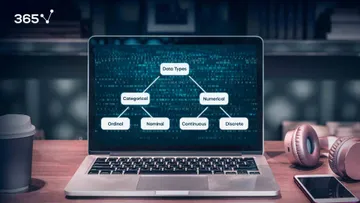Deep learning is a subset of machine learning that has significantly advanced the field of artificial intelligence by enabling computers to learn and understand like the human brain.
By using neural networks that mimic brain cells, it helps computers independently discover patterns in data, leading to breakthroughs in image recognition, speech understanding, and natural language processing.
In this beginner’s guide, we'll answer the question: “What is deep learning?” We’ll also explore how it works, its real-world applications, and how you can learn this in-demand skill.
If you’re more of a visual learner, check out our video here: Deep Learning Explained
Let's begin our discussion by exploring what deep learning is.
Table of Contents
Understanding Deep Learning: The Basics
How Deep Learning Works: The Neural Network Architecture
Deep Learning vs. Machine Learning: Understanding the Difference
The Building Blocks of Deep Learning Models
A Practical Example: The MNIST Database
Common Applications of Deep Learning in Artificial Intelligence
Challenges and Considerations in Deep Learning
The Future of Deep Learning Technology
Getting Started with Deep Learning
Understanding Deep Learning: The Basics

What is the definition of deep learning? It refers to an advanced form of artificial intelligence that mimics the human brain's ability to learn and process information. The meaning of deep learning goes beyond simple pattern recognition—it's a fundamental shift in how machines can understand and interpret complex data.
What makes deep learning unique is its use of Artificial Neural Networks (ANNs), which process information through multiple interconnected layers. This layered approach allows for increasingly sophisticated levels of abstraction and understanding, similar to how our brains process information.
Unlike traditional machine learning approaches, deep learning models excel at identifying complex patterns and features in data. Each layer in a deep learning model builds upon the previous one, enabling increasingly sophisticated levels of pattern recognition.
How Deep Learning Works: The Neural Network Architecture
Deep learning technology operates through artificial neural networks, which consist of three main components:
- Input Layer: Receives raw data and distributes it to subsequent layers
- Hidden Layers: Process and transform the data through multiple levels of abstraction
- Output Layer: Produces the final result based on the processed information

What makes deep learning AI particularly powerful is its ability to automatically learn features from data without explicit programming. This is achieved through a process called supervised learning, where the model learns from labeled examples to make predictions or classifications.
Deep Learning vs. Machine Learning: Understanding the Difference
One question that often comes up when discussing “what is deep learning” is how it differs from machine learning. So, what is the difference between deep learning and machine learning?
While deep learning is a subset of machine learning, it differs in several key ways:
- Feature Learning: Deep learning models automatically learn important features, while traditional machine learning often requires manual feature engineering
- Data Requirements: Deep learning typically needs more data to perform effectively
- Processing Power: Deep learning models generally require more computational resources
- Complexity: Deep learning models can handle more complex patterns and relationships in data
- Interpretability: While we can generally understand ML model output results and interpret their reasoning, deep learning models are more like "black boxes," making it difficult to understand how they reach certain conclusions
The Building Blocks of Deep Learning Models

Deep learning models are built from several key components that work together to process information, similar to how our brains work:
- Artificial Neurons: Like simplified versions of brain cells, these are computational units that receive, process, and transmit information through the network
- Weights and Biases: These are numbers that the network adjusts during training to learn from data, like turning knobs to fine-tune the system
- Activation Functions: Mathematical operations that help determine when neurons should pass information forward, allowing the network to learn complex patterns
- Loss Functions: Mathematical tools that measure how accurate the model's predictions are, helping the network improve its performance during training
How These Components Work Together
Let's see how these components interact in a simple example of image recognition:
- Input Processing: When an image enters the network, artificial neurons in the input layer receive pixel values as data
- Information Flow: Each neuron multiplies this input by its weights (like adjusting the importance of different features) and adds a bias
- Decision Making: The activation function then decides whether this combined value is significant enough to "fire" the neuron and pass information forward
- Learning Process: The loss function measures how far off the prediction was from the correct answer. If the network thinks a cat image is a dog, the high loss value triggers adjustments to weights and biases
This process repeats thousands of times during training, with the network gradually improving its accuracy by fine-tuning these components based on its mistakes.
A Practical Example: The MNIST Database

To really understand what deep learning is, it’s easiest to look at practical case-studies. Let's look at a real example of how deep learning works by considering how it learns to read handwritten numbers.
Imagine you're teaching a child to recognize numbers—you'd show them lots of examples of each number until they learn what makes a "2" look different from a "3". Deep learning works similarly with a famous training dataset called MNIST, which contains thousands of handwritten numbers.
Think of it like this: when you look at a handwritten number, your brain processes it in stages. First, you see basic lines and curves, then you combine these into meaningful shapes, and finally, you recognize it as a specific number. Deep learning follows the same process:
- Step 1: The model first learns to spot simple features like straight lines, curves, and loops—just like noticing that a "7" has a straight line across the top
- Step 2: It then learns to combine these basic shapes—for example, understanding that a "8" is made up of two loops stacked on top of each other
- Step 3: Finally, after seeing thousands of examples, it can confidently say "This is definitely a 4" or "This looks like a 9" based on all the patterns it has learned
This process shows how deep learning mimics human learning—it starts with basic building blocks and gradually builds up to complex understanding, just like how we learn to read and write.
Common Applications of Deep Learning in Artificial Intelligence
Deep learning has found numerous applications across various industries. Here are some common use cases:
- Image Recognition: Used in facial recognition systems, medical imaging, and autonomous vehicles
- Natural Language Processing: Powers chatbots, language translation services, and content generation (check out our Intro to NLP course for more information)
- Generative AI: Creates new content like images, text, and music (our Intro to ChatGPT and Generative AI course will give you a better understanding on this topic)
- Pattern Recognition: Used in fraud detection, market analysis, and scientific research
Challenges and Considerations in Deep Learning
By now, you should have a better answer to the question: “What is deep learning?” But if you’re interested in the subject, there are some other considerations to keep in mind.
While deep learning technology offers remarkable capabilities, it's important to understand its challenges:
Data Quality and Quantity
Deep learning models require massive amounts of high-quality training data to perform effectively. Without sufficient clean data, models may fail to learn meaningful patterns or make accurate predictions.
Computational Requirements
Training complex deep learning models demands substantial computational resources, including powerful GPUs and specialized hardware. This can make implementation costly and resource-intensive for organizations.
Model Transparency
One of the biggest challenges in deep learning is understanding how models arrive at their decisions. This lack of interpretability can make it difficult to trust and validate model outputs, especially in critical applications.
Ethical Implications
Deep learning systems raise important ethical concerns around data privacy, algorithmic bias, and responsible AI deployment. Organizations must carefully consider these implications when implementing deep learning solutions.
The Future of Deep Learning Technology
As deep learning continues to evolve, we're seeing increasingly sophisticated deep learning models and applications. From autonomous vehicles to medical diagnosis, deep learning is transforming how we interact with technology and solve complex problems.
Emerging trends in deep learning include:
- More efficient training methods
- Enhanced model interpretability
- Integration with edge computing
- Advanced generative AI capabilities
Check out some of the latest AI trends in our article.
Understanding deep learning is becoming increasingly important for students, professionals, and enthusiasts in today's AI-driven world. It’s a tough subject for sure, but with the right resources and dedication, anyone can begin to explore this fascinating field.
Getting Started with Deep Learning
For those interested in exploring deep learning, there are several ways to begin. One popular approach is learning deep learning with TensorFlow, a powerful framework for building and training neural networks.
To start your journey in deep learning, you'll need to:
- Understand the basic concepts of machine learning and neural networks
- Learn a programming language (Python is most common)
- Master deep learning frameworks like TensorFlow
- Practice with real-world datasets and problems
You can master these skills through 365 Data Science's comprehensive courses. Start with Python basics to build a strong programming foundation, progress through introductory to advanced machine learning courses to understand core concepts, and finally jump into Deep Learning with TensorFlow 2 to master neural networks and their applications.
No matter your starting point, we offer comprehensive courses to help you fully understand what is deep learning and master its applications.
FAQs







